Tax Assignment Report: CGT, Capital Allowances, and Tax Advice
VerifiedAdded on 2022/11/13
|7
|2465
|196
Report
AI Summary
This report provides a detailed analysis of two tax-related scenarios. The first part addresses capital gains tax (CGT) implications for Jasmine, an Australian resident selling various assets, including her home, car, business assets, and personal items. It offers advice on CGT exemptions and liabilities based on Australian tax laws, considering the main residence exemption, small business concessions, and rules for collectibles. The second part focuses on capital allowances for John, a business owner who imported a CNC machine. It calculates the machine's cost for capital allowance purposes, including travel and installation expenses, and determines the start date for calculating the asset's depreciation based on Australian taxation regulations. The report utilizes relevant legislation and provides clear, practical advice on both CGT and capital allowances.
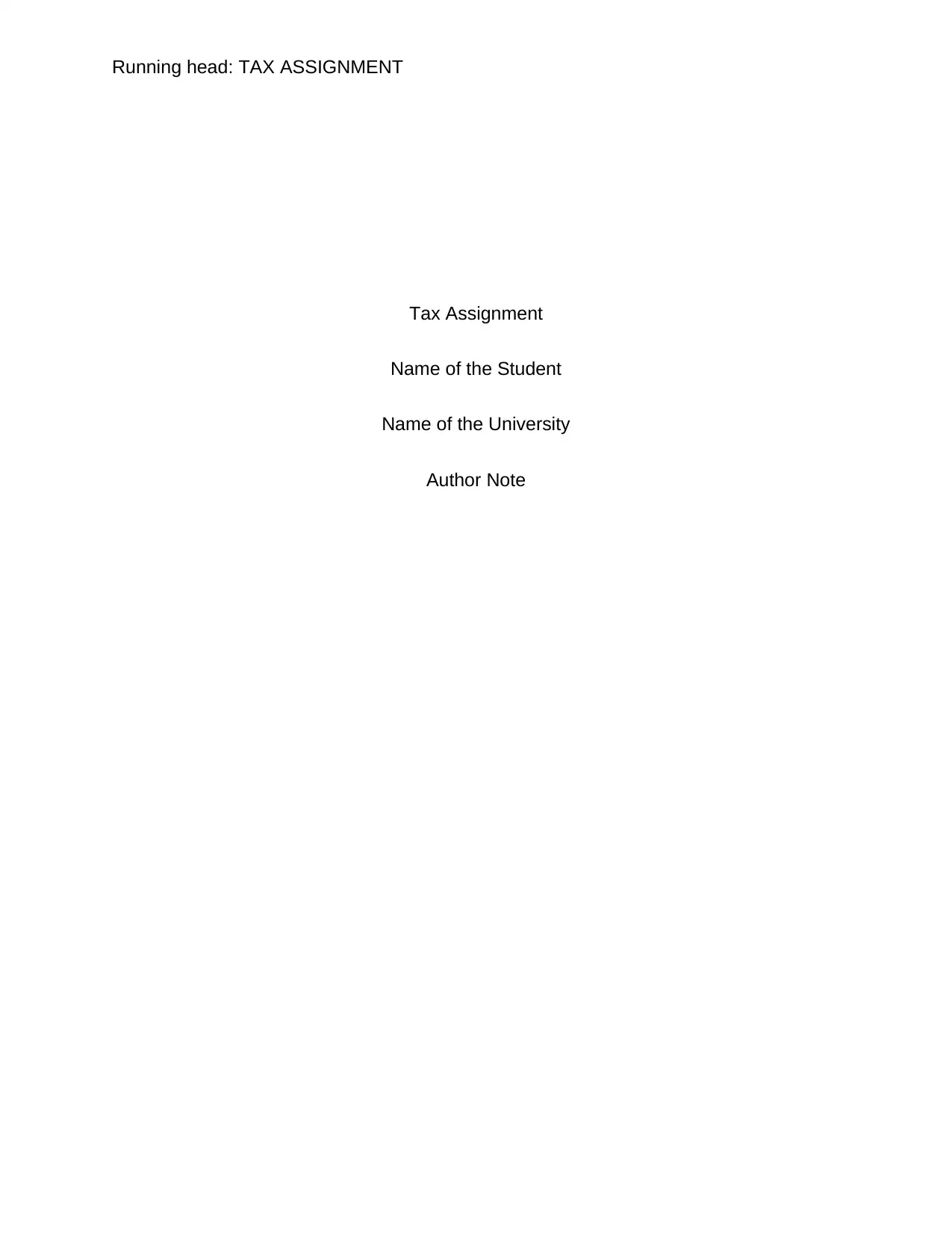
Running head: TAX ASSIGNMENT
Tax Assignment
Name of the Student
Name of the University
Author Note
Tax Assignment
Name of the Student
Name of the University
Author Note
Paraphrase This Document
Need a fresh take? Get an instant paraphrase of this document with our AI Paraphraser
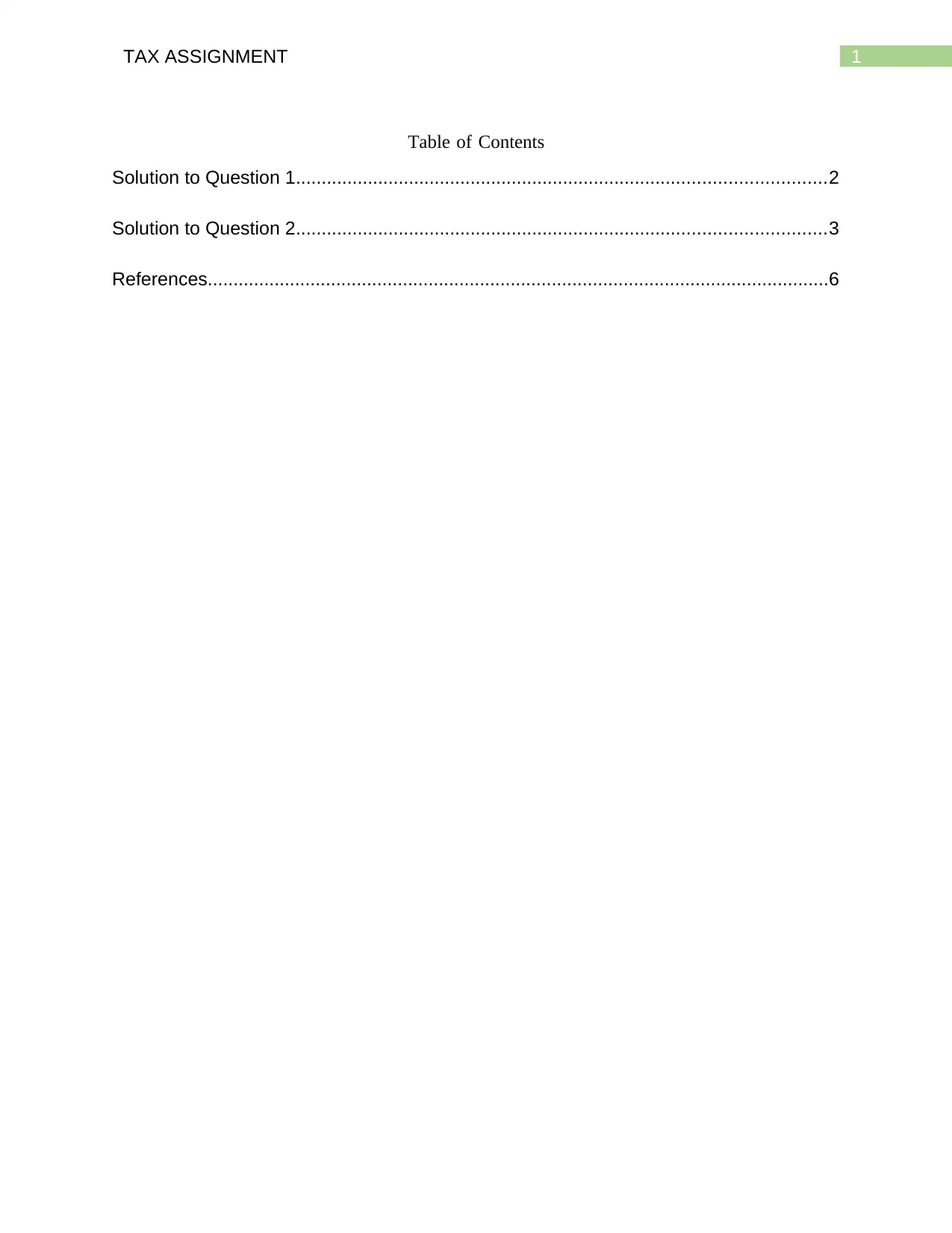
1TAX ASSIGNMENT
Table of Contents
Solution to Question 1.......................................................................................................2
Solution to Question 2.......................................................................................................3
References.........................................................................................................................6
Table of Contents
Solution to Question 1.......................................................................................................2
Solution to Question 2.......................................................................................................3
References.........................................................................................................................6
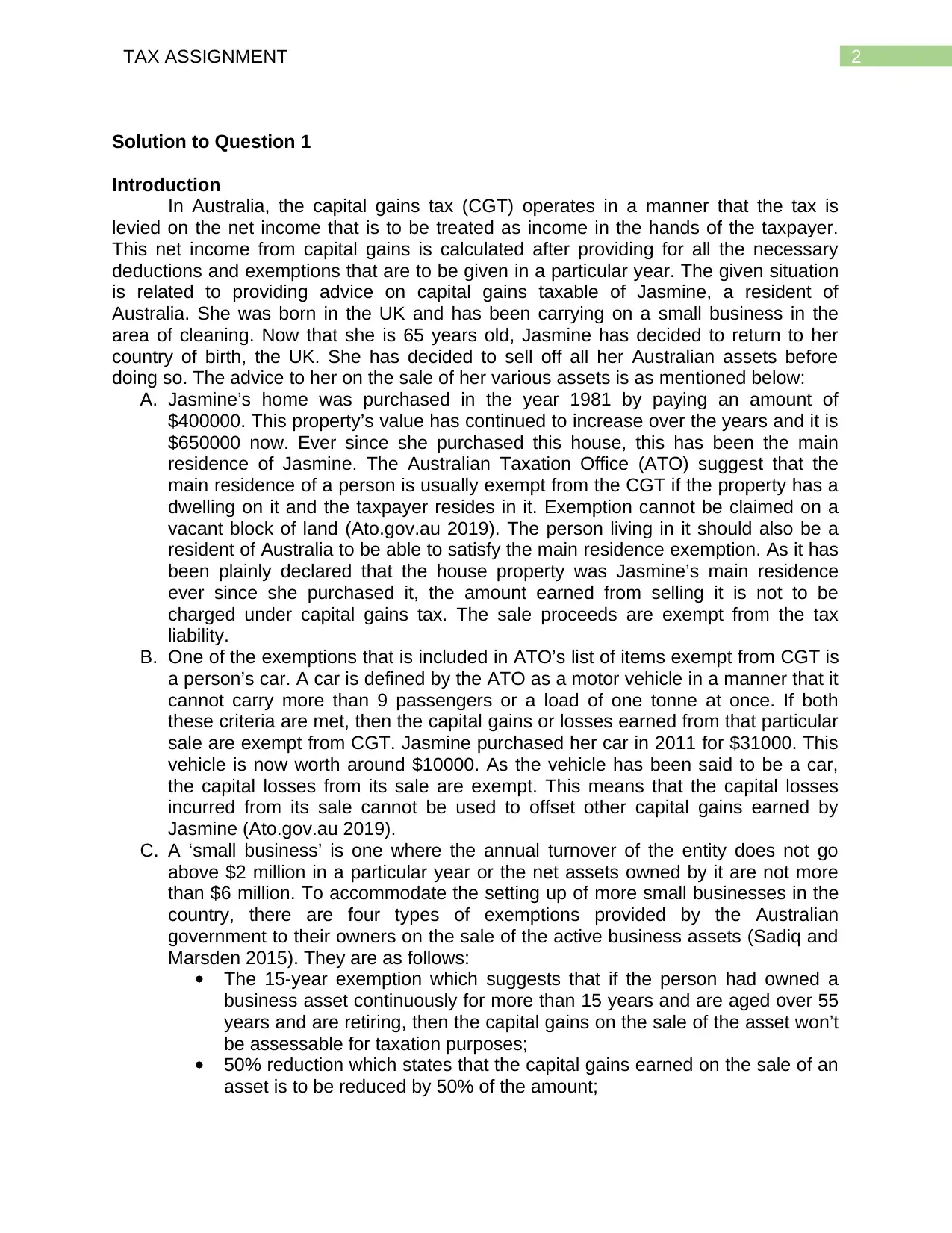
2TAX ASSIGNMENT
Solution to Question 1
Introduction
In Australia, the capital gains tax (CGT) operates in a manner that the tax is
levied on the net income that is to be treated as income in the hands of the taxpayer.
This net income from capital gains is calculated after providing for all the necessary
deductions and exemptions that are to be given in a particular year. The given situation
is related to providing advice on capital gains taxable of Jasmine, a resident of
Australia. She was born in the UK and has been carrying on a small business in the
area of cleaning. Now that she is 65 years old, Jasmine has decided to return to her
country of birth, the UK. She has decided to sell off all her Australian assets before
doing so. The advice to her on the sale of her various assets is as mentioned below:
A. Jasmine’s home was purchased in the year 1981 by paying an amount of
$400000. This property’s value has continued to increase over the years and it is
$650000 now. Ever since she purchased this house, this has been the main
residence of Jasmine. The Australian Taxation Office (ATO) suggest that the
main residence of a person is usually exempt from the CGT if the property has a
dwelling on it and the taxpayer resides in it. Exemption cannot be claimed on a
vacant block of land (Ato.gov.au 2019). The person living in it should also be a
resident of Australia to be able to satisfy the main residence exemption. As it has
been plainly declared that the house property was Jasmine’s main residence
ever since she purchased it, the amount earned from selling it is not to be
charged under capital gains tax. The sale proceeds are exempt from the tax
liability.
B. One of the exemptions that is included in ATO’s list of items exempt from CGT is
a person’s car. A car is defined by the ATO as a motor vehicle in a manner that it
cannot carry more than 9 passengers or a load of one tonne at once. If both
these criteria are met, then the capital gains or losses earned from that particular
sale are exempt from CGT. Jasmine purchased her car in 2011 for $31000. This
vehicle is now worth around $10000. As the vehicle has been said to be a car,
the capital losses from its sale are exempt. This means that the capital losses
incurred from its sale cannot be used to offset other capital gains earned by
Jasmine (Ato.gov.au 2019).
C. A ‘small business’ is one where the annual turnover of the entity does not go
above $2 million in a particular year or the net assets owned by it are not more
than $6 million. To accommodate the setting up of more small businesses in the
country, there are four types of exemptions provided by the Australian
government to their owners on the sale of the active business assets (Sadiq and
Marsden 2015). They are as follows:
The 15-year exemption which suggests that if the person had owned a
business asset continuously for more than 15 years and are aged over 55
years and are retiring, then the capital gains on the sale of the asset won’t
be assessable for taxation purposes;
50% reduction which states that the capital gains earned on the sale of an
asset is to be reduced by 50% of the amount;
Solution to Question 1
Introduction
In Australia, the capital gains tax (CGT) operates in a manner that the tax is
levied on the net income that is to be treated as income in the hands of the taxpayer.
This net income from capital gains is calculated after providing for all the necessary
deductions and exemptions that are to be given in a particular year. The given situation
is related to providing advice on capital gains taxable of Jasmine, a resident of
Australia. She was born in the UK and has been carrying on a small business in the
area of cleaning. Now that she is 65 years old, Jasmine has decided to return to her
country of birth, the UK. She has decided to sell off all her Australian assets before
doing so. The advice to her on the sale of her various assets is as mentioned below:
A. Jasmine’s home was purchased in the year 1981 by paying an amount of
$400000. This property’s value has continued to increase over the years and it is
$650000 now. Ever since she purchased this house, this has been the main
residence of Jasmine. The Australian Taxation Office (ATO) suggest that the
main residence of a person is usually exempt from the CGT if the property has a
dwelling on it and the taxpayer resides in it. Exemption cannot be claimed on a
vacant block of land (Ato.gov.au 2019). The person living in it should also be a
resident of Australia to be able to satisfy the main residence exemption. As it has
been plainly declared that the house property was Jasmine’s main residence
ever since she purchased it, the amount earned from selling it is not to be
charged under capital gains tax. The sale proceeds are exempt from the tax
liability.
B. One of the exemptions that is included in ATO’s list of items exempt from CGT is
a person’s car. A car is defined by the ATO as a motor vehicle in a manner that it
cannot carry more than 9 passengers or a load of one tonne at once. If both
these criteria are met, then the capital gains or losses earned from that particular
sale are exempt from CGT. Jasmine purchased her car in 2011 for $31000. This
vehicle is now worth around $10000. As the vehicle has been said to be a car,
the capital losses from its sale are exempt. This means that the capital losses
incurred from its sale cannot be used to offset other capital gains earned by
Jasmine (Ato.gov.au 2019).
C. A ‘small business’ is one where the annual turnover of the entity does not go
above $2 million in a particular year or the net assets owned by it are not more
than $6 million. To accommodate the setting up of more small businesses in the
country, there are four types of exemptions provided by the Australian
government to their owners on the sale of the active business assets (Sadiq and
Marsden 2015). They are as follows:
The 15-year exemption which suggests that if the person had owned a
business asset continuously for more than 15 years and are aged over 55
years and are retiring, then the capital gains on the sale of the asset won’t
be assessable for taxation purposes;
50% reduction which states that the capital gains earned on the sale of an
asset is to be reduced by 50% of the amount;
⊘ This is a preview!⊘
Do you want full access?
Subscribe today to unlock all pages.

Trusted by 1+ million students worldwide
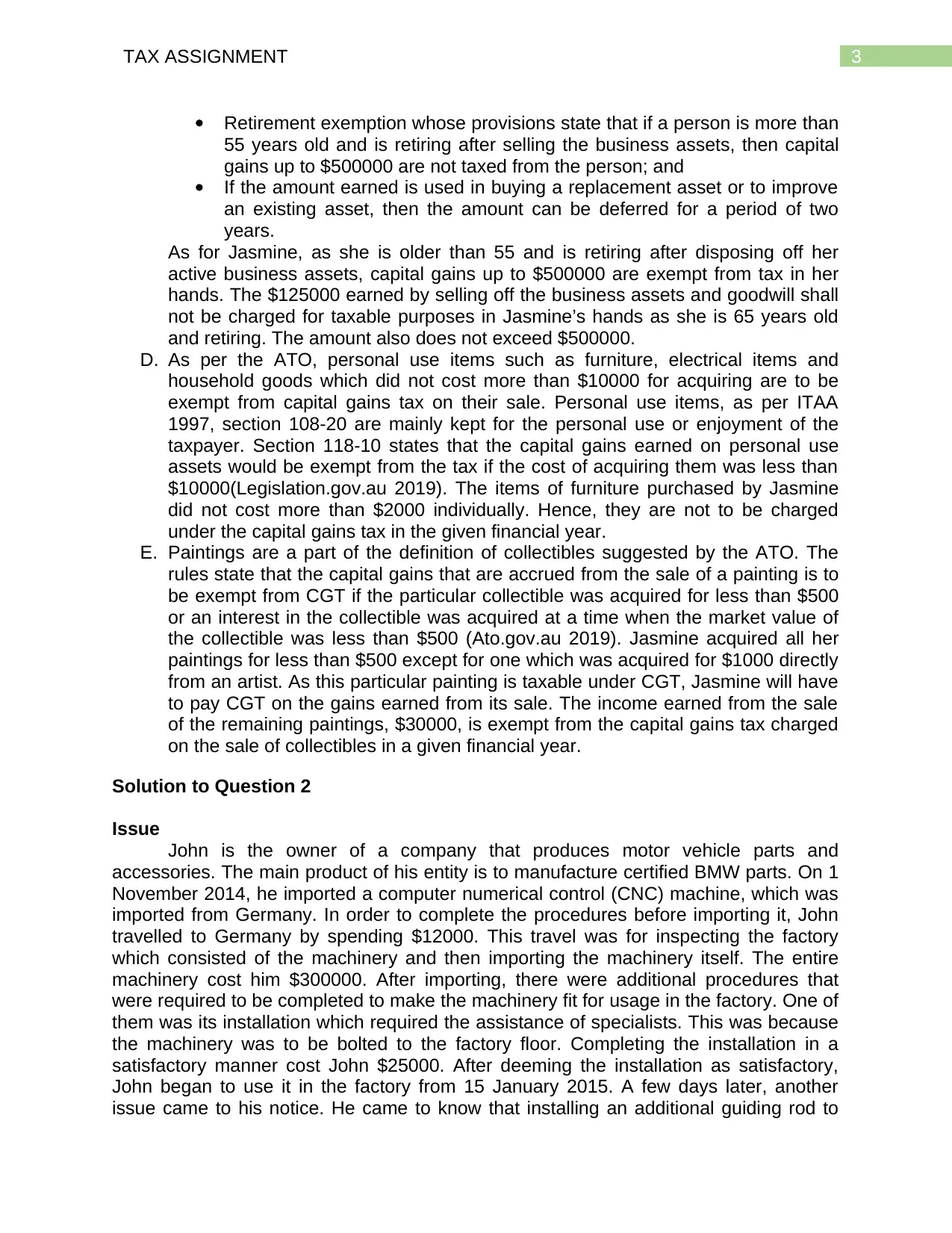
3TAX ASSIGNMENT
Retirement exemption whose provisions state that if a person is more than
55 years old and is retiring after selling the business assets, then capital
gains up to $500000 are not taxed from the person; and
If the amount earned is used in buying a replacement asset or to improve
an existing asset, then the amount can be deferred for a period of two
years.
As for Jasmine, as she is older than 55 and is retiring after disposing off her
active business assets, capital gains up to $500000 are exempt from tax in her
hands. The $125000 earned by selling off the business assets and goodwill shall
not be charged for taxable purposes in Jasmine’s hands as she is 65 years old
and retiring. The amount also does not exceed $500000.
D. As per the ATO, personal use items such as furniture, electrical items and
household goods which did not cost more than $10000 for acquiring are to be
exempt from capital gains tax on their sale. Personal use items, as per ITAA
1997, section 108-20 are mainly kept for the personal use or enjoyment of the
taxpayer. Section 118-10 states that the capital gains earned on personal use
assets would be exempt from the tax if the cost of acquiring them was less than
$10000(Legislation.gov.au 2019). The items of furniture purchased by Jasmine
did not cost more than $2000 individually. Hence, they are not to be charged
under the capital gains tax in the given financial year.
E. Paintings are a part of the definition of collectibles suggested by the ATO. The
rules state that the capital gains that are accrued from the sale of a painting is to
be exempt from CGT if the particular collectible was acquired for less than $500
or an interest in the collectible was acquired at a time when the market value of
the collectible was less than $500 (Ato.gov.au 2019). Jasmine acquired all her
paintings for less than $500 except for one which was acquired for $1000 directly
from an artist. As this particular painting is taxable under CGT, Jasmine will have
to pay CGT on the gains earned from its sale. The income earned from the sale
of the remaining paintings, $30000, is exempt from the capital gains tax charged
on the sale of collectibles in a given financial year.
Solution to Question 2
Issue
John is the owner of a company that produces motor vehicle parts and
accessories. The main product of his entity is to manufacture certified BMW parts. On 1
November 2014, he imported a computer numerical control (CNC) machine, which was
imported from Germany. In order to complete the procedures before importing it, John
travelled to Germany by spending $12000. This travel was for inspecting the factory
which consisted of the machinery and then importing the machinery itself. The entire
machinery cost him $300000. After importing, there were additional procedures that
were required to be completed to make the machinery fit for usage in the factory. One of
them was its installation which required the assistance of specialists. This was because
the machinery was to be bolted to the factory floor. Completing the installation in a
satisfactory manner cost John $25000. After deeming the installation as satisfactory,
John began to use it in the factory from 15 January 2015. A few days later, another
issue came to his notice. He came to know that installing an additional guiding rod to
Retirement exemption whose provisions state that if a person is more than
55 years old and is retiring after selling the business assets, then capital
gains up to $500000 are not taxed from the person; and
If the amount earned is used in buying a replacement asset or to improve
an existing asset, then the amount can be deferred for a period of two
years.
As for Jasmine, as she is older than 55 and is retiring after disposing off her
active business assets, capital gains up to $500000 are exempt from tax in her
hands. The $125000 earned by selling off the business assets and goodwill shall
not be charged for taxable purposes in Jasmine’s hands as she is 65 years old
and retiring. The amount also does not exceed $500000.
D. As per the ATO, personal use items such as furniture, electrical items and
household goods which did not cost more than $10000 for acquiring are to be
exempt from capital gains tax on their sale. Personal use items, as per ITAA
1997, section 108-20 are mainly kept for the personal use or enjoyment of the
taxpayer. Section 118-10 states that the capital gains earned on personal use
assets would be exempt from the tax if the cost of acquiring them was less than
$10000(Legislation.gov.au 2019). The items of furniture purchased by Jasmine
did not cost more than $2000 individually. Hence, they are not to be charged
under the capital gains tax in the given financial year.
E. Paintings are a part of the definition of collectibles suggested by the ATO. The
rules state that the capital gains that are accrued from the sale of a painting is to
be exempt from CGT if the particular collectible was acquired for less than $500
or an interest in the collectible was acquired at a time when the market value of
the collectible was less than $500 (Ato.gov.au 2019). Jasmine acquired all her
paintings for less than $500 except for one which was acquired for $1000 directly
from an artist. As this particular painting is taxable under CGT, Jasmine will have
to pay CGT on the gains earned from its sale. The income earned from the sale
of the remaining paintings, $30000, is exempt from the capital gains tax charged
on the sale of collectibles in a given financial year.
Solution to Question 2
Issue
John is the owner of a company that produces motor vehicle parts and
accessories. The main product of his entity is to manufacture certified BMW parts. On 1
November 2014, he imported a computer numerical control (CNC) machine, which was
imported from Germany. In order to complete the procedures before importing it, John
travelled to Germany by spending $12000. This travel was for inspecting the factory
which consisted of the machinery and then importing the machinery itself. The entire
machinery cost him $300000. After importing, there were additional procedures that
were required to be completed to make the machinery fit for usage in the factory. One of
them was its installation which required the assistance of specialists. This was because
the machinery was to be bolted to the factory floor. Completing the installation in a
satisfactory manner cost John $25000. After deeming the installation as satisfactory,
John began to use it in the factory from 15 January 2015. A few days later, another
issue came to his notice. He came to know that installing an additional guiding rod to
Paraphrase This Document
Need a fresh take? Get an instant paraphrase of this document with our AI Paraphraser
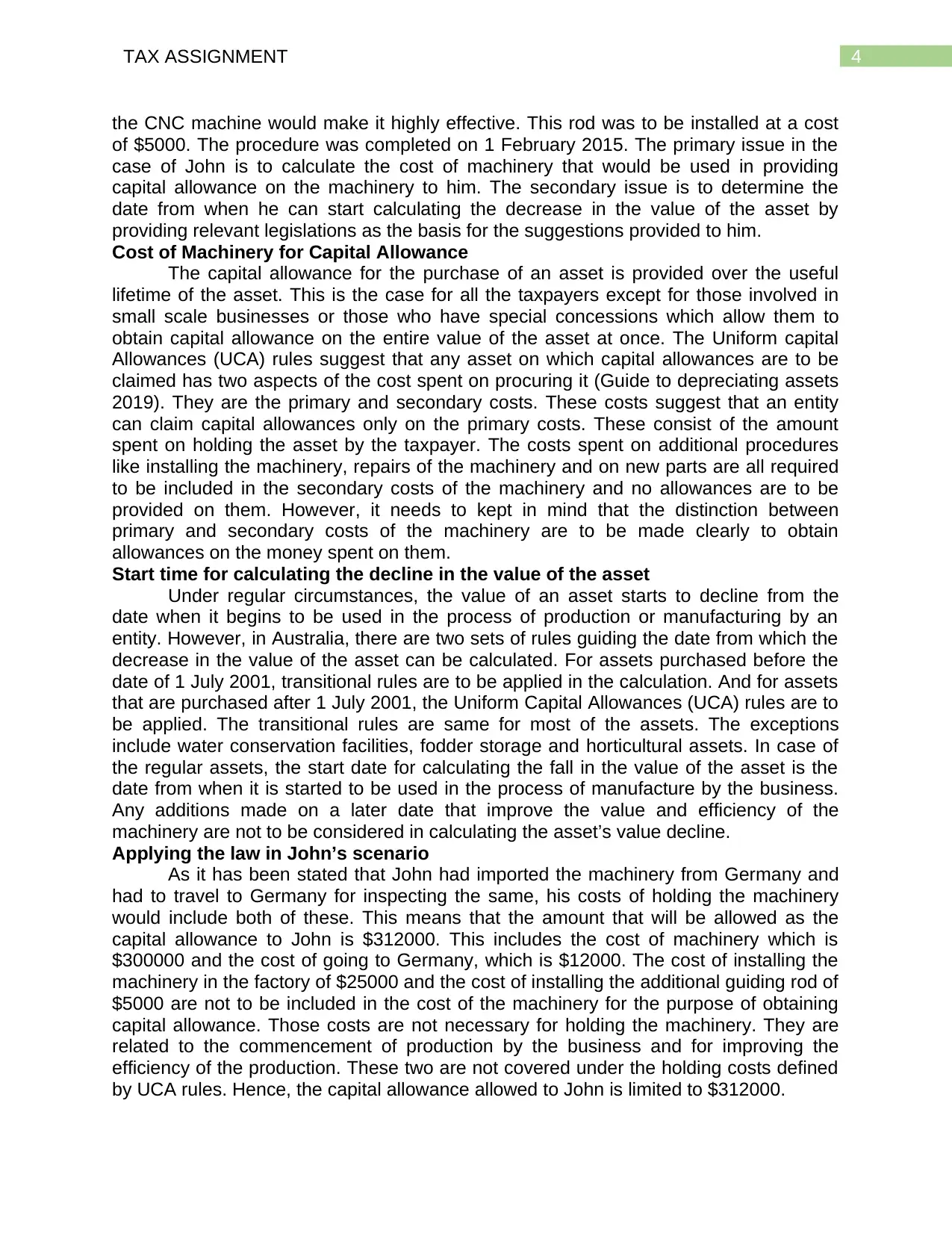
4TAX ASSIGNMENT
the CNC machine would make it highly effective. This rod was to be installed at a cost
of $5000. The procedure was completed on 1 February 2015. The primary issue in the
case of John is to calculate the cost of machinery that would be used in providing
capital allowance on the machinery to him. The secondary issue is to determine the
date from when he can start calculating the decrease in the value of the asset by
providing relevant legislations as the basis for the suggestions provided to him.
Cost of Machinery for Capital Allowance
The capital allowance for the purchase of an asset is provided over the useful
lifetime of the asset. This is the case for all the taxpayers except for those involved in
small scale businesses or those who have special concessions which allow them to
obtain capital allowance on the entire value of the asset at once. The Uniform capital
Allowances (UCA) rules suggest that any asset on which capital allowances are to be
claimed has two aspects of the cost spent on procuring it (Guide to depreciating assets
2019). They are the primary and secondary costs. These costs suggest that an entity
can claim capital allowances only on the primary costs. These consist of the amount
spent on holding the asset by the taxpayer. The costs spent on additional procedures
like installing the machinery, repairs of the machinery and on new parts are all required
to be included in the secondary costs of the machinery and no allowances are to be
provided on them. However, it needs to kept in mind that the distinction between
primary and secondary costs of the machinery are to be made clearly to obtain
allowances on the money spent on them.
Start time for calculating the decline in the value of the asset
Under regular circumstances, the value of an asset starts to decline from the
date when it begins to be used in the process of production or manufacturing by an
entity. However, in Australia, there are two sets of rules guiding the date from which the
decrease in the value of the asset can be calculated. For assets purchased before the
date of 1 July 2001, transitional rules are to be applied in the calculation. And for assets
that are purchased after 1 July 2001, the Uniform Capital Allowances (UCA) rules are to
be applied. The transitional rules are same for most of the assets. The exceptions
include water conservation facilities, fodder storage and horticultural assets. In case of
the regular assets, the start date for calculating the fall in the value of the asset is the
date from when it is started to be used in the process of manufacture by the business.
Any additions made on a later date that improve the value and efficiency of the
machinery are not to be considered in calculating the asset’s value decline.
Applying the law in John’s scenario
As it has been stated that John had imported the machinery from Germany and
had to travel to Germany for inspecting the same, his costs of holding the machinery
would include both of these. This means that the amount that will be allowed as the
capital allowance to John is $312000. This includes the cost of machinery which is
$300000 and the cost of going to Germany, which is $12000. The cost of installing the
machinery in the factory of $25000 and the cost of installing the additional guiding rod of
$5000 are not to be included in the cost of the machinery for the purpose of obtaining
capital allowance. Those costs are not necessary for holding the machinery. They are
related to the commencement of production by the business and for improving the
efficiency of the production. These two are not covered under the holding costs defined
by UCA rules. Hence, the capital allowance allowed to John is limited to $312000.
the CNC machine would make it highly effective. This rod was to be installed at a cost
of $5000. The procedure was completed on 1 February 2015. The primary issue in the
case of John is to calculate the cost of machinery that would be used in providing
capital allowance on the machinery to him. The secondary issue is to determine the
date from when he can start calculating the decrease in the value of the asset by
providing relevant legislations as the basis for the suggestions provided to him.
Cost of Machinery for Capital Allowance
The capital allowance for the purchase of an asset is provided over the useful
lifetime of the asset. This is the case for all the taxpayers except for those involved in
small scale businesses or those who have special concessions which allow them to
obtain capital allowance on the entire value of the asset at once. The Uniform capital
Allowances (UCA) rules suggest that any asset on which capital allowances are to be
claimed has two aspects of the cost spent on procuring it (Guide to depreciating assets
2019). They are the primary and secondary costs. These costs suggest that an entity
can claim capital allowances only on the primary costs. These consist of the amount
spent on holding the asset by the taxpayer. The costs spent on additional procedures
like installing the machinery, repairs of the machinery and on new parts are all required
to be included in the secondary costs of the machinery and no allowances are to be
provided on them. However, it needs to kept in mind that the distinction between
primary and secondary costs of the machinery are to be made clearly to obtain
allowances on the money spent on them.
Start time for calculating the decline in the value of the asset
Under regular circumstances, the value of an asset starts to decline from the
date when it begins to be used in the process of production or manufacturing by an
entity. However, in Australia, there are two sets of rules guiding the date from which the
decrease in the value of the asset can be calculated. For assets purchased before the
date of 1 July 2001, transitional rules are to be applied in the calculation. And for assets
that are purchased after 1 July 2001, the Uniform Capital Allowances (UCA) rules are to
be applied. The transitional rules are same for most of the assets. The exceptions
include water conservation facilities, fodder storage and horticultural assets. In case of
the regular assets, the start date for calculating the fall in the value of the asset is the
date from when it is started to be used in the process of manufacture by the business.
Any additions made on a later date that improve the value and efficiency of the
machinery are not to be considered in calculating the asset’s value decline.
Applying the law in John’s scenario
As it has been stated that John had imported the machinery from Germany and
had to travel to Germany for inspecting the same, his costs of holding the machinery
would include both of these. This means that the amount that will be allowed as the
capital allowance to John is $312000. This includes the cost of machinery which is
$300000 and the cost of going to Germany, which is $12000. The cost of installing the
machinery in the factory of $25000 and the cost of installing the additional guiding rod of
$5000 are not to be included in the cost of the machinery for the purpose of obtaining
capital allowance. Those costs are not necessary for holding the machinery. They are
related to the commencement of production by the business and for improving the
efficiency of the production. These two are not covered under the holding costs defined
by UCA rules. Hence, the capital allowance allowed to John is limited to $312000.
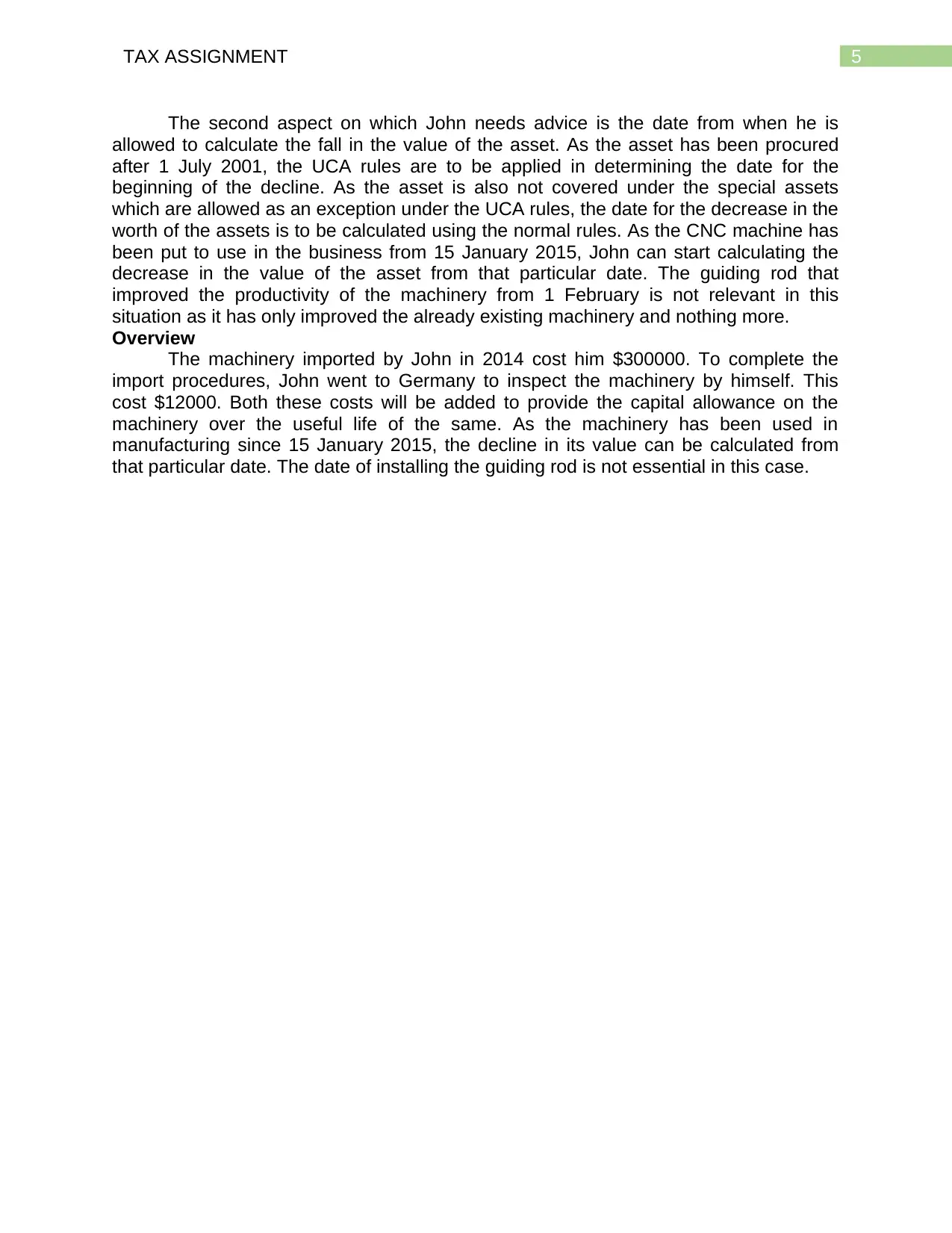
5TAX ASSIGNMENT
The second aspect on which John needs advice is the date from when he is
allowed to calculate the fall in the value of the asset. As the asset has been procured
after 1 July 2001, the UCA rules are to be applied in determining the date for the
beginning of the decline. As the asset is also not covered under the special assets
which are allowed as an exception under the UCA rules, the date for the decrease in the
worth of the assets is to be calculated using the normal rules. As the CNC machine has
been put to use in the business from 15 January 2015, John can start calculating the
decrease in the value of the asset from that particular date. The guiding rod that
improved the productivity of the machinery from 1 February is not relevant in this
situation as it has only improved the already existing machinery and nothing more.
Overview
The machinery imported by John in 2014 cost him $300000. To complete the
import procedures, John went to Germany to inspect the machinery by himself. This
cost $12000. Both these costs will be added to provide the capital allowance on the
machinery over the useful life of the same. As the machinery has been used in
manufacturing since 15 January 2015, the decline in its value can be calculated from
that particular date. The date of installing the guiding rod is not essential in this case.
The second aspect on which John needs advice is the date from when he is
allowed to calculate the fall in the value of the asset. As the asset has been procured
after 1 July 2001, the UCA rules are to be applied in determining the date for the
beginning of the decline. As the asset is also not covered under the special assets
which are allowed as an exception under the UCA rules, the date for the decrease in the
worth of the assets is to be calculated using the normal rules. As the CNC machine has
been put to use in the business from 15 January 2015, John can start calculating the
decrease in the value of the asset from that particular date. The guiding rod that
improved the productivity of the machinery from 1 February is not relevant in this
situation as it has only improved the already existing machinery and nothing more.
Overview
The machinery imported by John in 2014 cost him $300000. To complete the
import procedures, John went to Germany to inspect the machinery by himself. This
cost $12000. Both these costs will be added to provide the capital allowance on the
machinery over the useful life of the same. As the machinery has been used in
manufacturing since 15 January 2015, the decline in its value can be calculated from
that particular date. The date of installing the guiding rod is not essential in this case.
⊘ This is a preview!⊘
Do you want full access?
Subscribe today to unlock all pages.

Trusted by 1+ million students worldwide
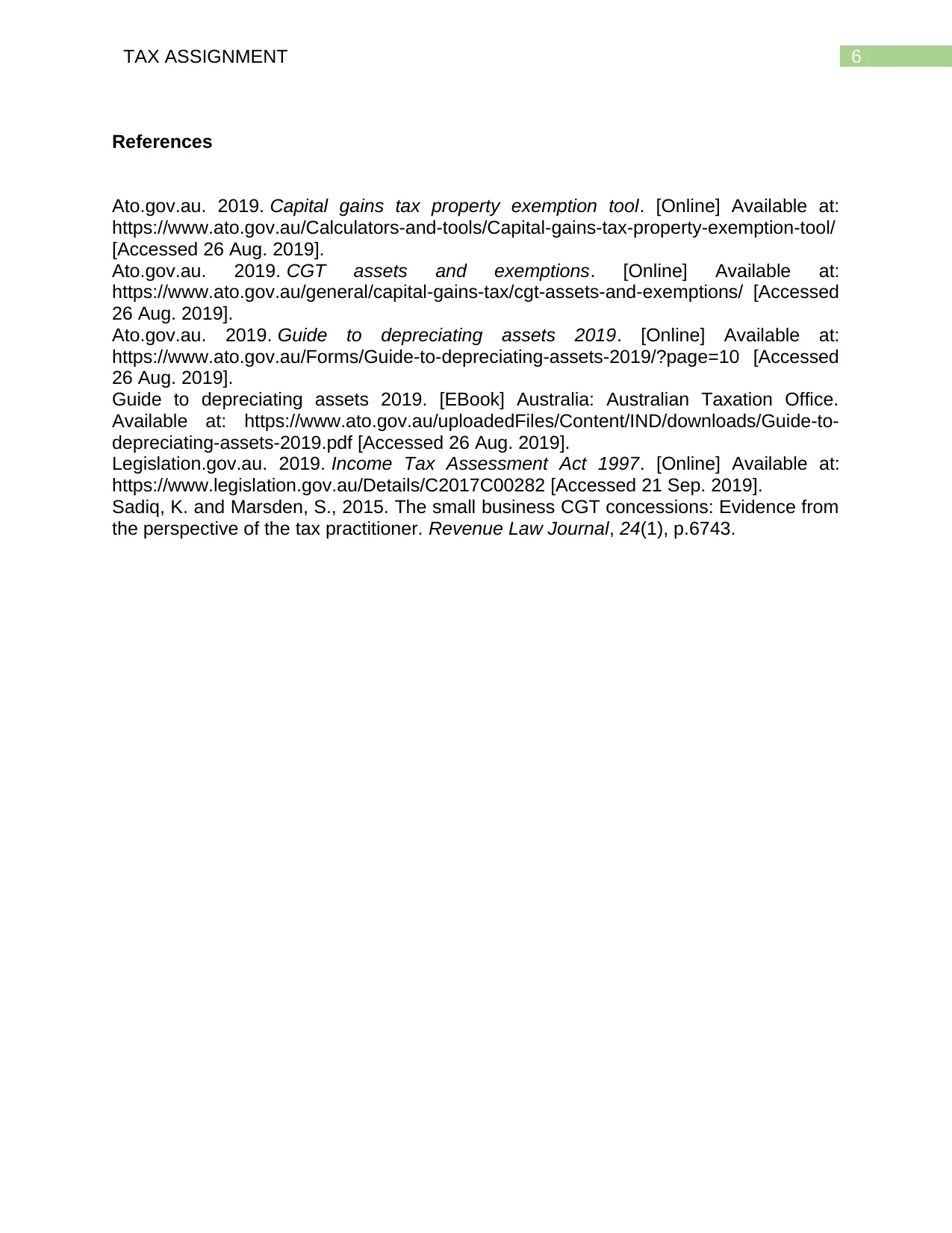
6TAX ASSIGNMENT
References
Ato.gov.au. 2019. Capital gains tax property exemption tool. [Online] Available at:
https://www.ato.gov.au/Calculators-and-tools/Capital-gains-tax-property-exemption-tool/
[Accessed 26 Aug. 2019].
Ato.gov.au. 2019. CGT assets and exemptions. [Online] Available at:
https://www.ato.gov.au/general/capital-gains-tax/cgt-assets-and-exemptions/ [Accessed
26 Aug. 2019].
Ato.gov.au. 2019. Guide to depreciating assets 2019. [Online] Available at:
https://www.ato.gov.au/Forms/Guide-to-depreciating-assets-2019/?page=10 [Accessed
26 Aug. 2019].
Guide to depreciating assets 2019. [EBook] Australia: Australian Taxation Office.
Available at: https://www.ato.gov.au/uploadedFiles/Content/IND/downloads/Guide-to-
depreciating-assets-2019.pdf [Accessed 26 Aug. 2019].
Legislation.gov.au. 2019. Income Tax Assessment Act 1997. [Online] Available at:
https://www.legislation.gov.au/Details/C2017C00282 [Accessed 21 Sep. 2019].
Sadiq, K. and Marsden, S., 2015. The small business CGT concessions: Evidence from
the perspective of the tax practitioner. Revenue Law Journal, 24(1), p.6743.
References
Ato.gov.au. 2019. Capital gains tax property exemption tool. [Online] Available at:
https://www.ato.gov.au/Calculators-and-tools/Capital-gains-tax-property-exemption-tool/
[Accessed 26 Aug. 2019].
Ato.gov.au. 2019. CGT assets and exemptions. [Online] Available at:
https://www.ato.gov.au/general/capital-gains-tax/cgt-assets-and-exemptions/ [Accessed
26 Aug. 2019].
Ato.gov.au. 2019. Guide to depreciating assets 2019. [Online] Available at:
https://www.ato.gov.au/Forms/Guide-to-depreciating-assets-2019/?page=10 [Accessed
26 Aug. 2019].
Guide to depreciating assets 2019. [EBook] Australia: Australian Taxation Office.
Available at: https://www.ato.gov.au/uploadedFiles/Content/IND/downloads/Guide-to-
depreciating-assets-2019.pdf [Accessed 26 Aug. 2019].
Legislation.gov.au. 2019. Income Tax Assessment Act 1997. [Online] Available at:
https://www.legislation.gov.au/Details/C2017C00282 [Accessed 21 Sep. 2019].
Sadiq, K. and Marsden, S., 2015. The small business CGT concessions: Evidence from
the perspective of the tax practitioner. Revenue Law Journal, 24(1), p.6743.
1 out of 7
Related Documents
Your All-in-One AI-Powered Toolkit for Academic Success.
+13062052269
info@desklib.com
Available 24*7 on WhatsApp / Email
![[object Object]](/_next/static/media/star-bottom.7253800d.svg)
Unlock your academic potential
Copyright © 2020–2025 A2Z Services. All Rights Reserved. Developed and managed by ZUCOL.





